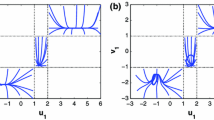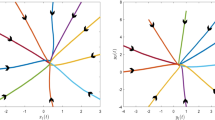Abstract
In this paper, the μ-stability of multiple equilibrium points (EPs) in the Cohen-Grossberg neural networks (CGNNs) is addressed by designing a kind of discontinuous activation function (AF). Under some criteria, CGNNs with this AF are shown to possess at least 5n EPs, of which 3n EPs are locally μ-stable. Compared with the saturated AF or the sigmoidal AF, CGNNs with the designed AF can produce many more total/stable EPs. Therefore, when CGNNs with the designed discontinuous AF are applied to associative memory, they can store more prototype patterns. Moreover, the AF is expanded to a more general version to further increase the number of total/stable equilibria. The CGNNs with the expanded AF are found to produce (2k + 3)n EPs, of which (k + 2)n EPs are locally μ-stable. By adjusting two parameters in the AF, the number of sufficient conditions ensuring the stability of multiple equilibria can be decreased. This finding implies that the computational complexity can be greatly reduced. Two numerical examples and an application to associative memory are illustrated to verify the correctness of the obtained results.
Similar content being viewed by others
References
Zhang H, Shan Q, Wang Z. Stability analysis of neural networks with two delay components based on dynamic delay interval method. IEEE Trans Neural Netw Learn Syst, 2015, 28: 259–267
Xu W J, Wang S, Bilal M. LEM-DEM coupling for slope stability analysis. Sci China Tech Sci, 2020, 63: 329–340
Gama F, Bruna J, Ribeiro A. Stability properties of graph neural networks. IEEE Trans Signal Process, 2020, 68: 5680–5695
Zhang H, Liu Z. Stability analysis for linear delayed systems via an optimally dividing delay interval approach. Automatica, 2011, 47: 2126–2129
Mao L H, Tian Y, Gao F, et al. Novel method of gait switching in six-legged robot walking on continuous-nondifferentiable terrain by utilizing stability and interference criteria. Sci China Tech Sci, 2020, 63: 2527–2540
Manickam I, Ramachandran R, Rajchakit G, et al. Novel Lagrange sense exponential stability criteria for time-delayed stochastic Cohen-Grossberg neural networks with Markovian jump parameters: A graph-theoretic approach. Nonlinear Anal Model, 2020, 25: 726–744
Yang D H, Zhima Z R, Wang Q, et al. Stability validation on the VLF waveform data of the China-Seismo-electromagnetic satellite. Sci China Tech Sci, 2022, 65: 3069–3078
Dong Z, Wang X, Zhang X. A nonsingular M-matrix-based global exponential stability analysis of higher-order delayed discrete-time Cohen-Grossberg neural networks. Appl Math Comput, 2020, 385: 125401
Zhang H G, Liu Z W, Huang G B, et al. Novel weighting-delay-based stability criteria for recurrent neural networks with time-varying delay. IEEE Trans Neural Netw, 2009, 21: 91–106
Forti M, Tesi A. New conditions for global stability of neural networks with application to linear and quadratic programming problems. IEEE Trans Circuits Syst I, 1995, 42: 354–366
Wei T, Lin P, Wang Y, et al. Stability of stochastic impulsive reaction-diffusion neural networks with S-type distributed delays and its application to image encryption. Neural Networks, 2019, 116: 35–45
Kong F, Zhu Q, Huang T. New fixed-time stability lemmas and applications to the discontinuous fuzzy inertial neural networks. IEEE Trans Fuzzy Syst, 2020, 29: 3711–3722
Murino V. Structured neural networks for pattern recognition. IEEE Trans Syst Man Cybern B, 1998, 28: 553–561
Pan C, Hong Q, Wang X. A novel memristive chaotic neuron circuit and its application in chaotic neural networks for associative memory. IEEE Trans Comput-Aided Des Integr Circuits Syst, 2020, 40: 521–532
Sun J W, Han G Y, Zeng Z G, et al. Memristor-based neural network circuit of full-function pavlov associative memory with time delay and variable learning rate. IEEE Trans Cybern, 2019, 50: 2935–2945
Nie X, Liang J, Cao J. Multistability analysis of competitive neural networks with Gaussian-wavelet-type activation functions and unbounded time-varying delays. Appl Math Comput, 2019, 356: 449–468
Wan P, Sun D, Zhao M, et al. Monostability and multistability for almost-periodic solutions of fractional-order neural networks with unsaturating piecewise linear activation functions. IEEE Trans Neural Netw Learn Syst, 2020, 31: 5138–5152
Bao H, Chen M, Wu H G, et al. Memristor initial-boosted coexisting plane bifurcations and its extreme multi-stability reconstitution in two-memristor-based dynamical system. Sci China Tech Sci, 2020, 63: 603–613
Zhang F, Zeng Z. Multistability of fractional-order neural networks with unbounded time-varying delays. IEEE Trans Neural Netw Learn Syst, 2020, 32: 177–187
Zhang F, Huang T, Wu Q, et al. Multistability of delayed fractional-order competitive neural networks. Neural Networks, 2021, 140: 325–335
Cheng C Y, Lin K H, Shih C W. Multistability in recurrent neural networks. SIAM J Appl Math, 2006, 66: 1301–1320
Zeng Z, Wang J, Liao X. Stability analysis of delayed cellular neural networks described using cloning templates. IEEE Trans Circuits Syst I, 2004, 51: 2313–2324
Kao Y, Li H. Asymptotic multistability and local S-asymptotic ω-periodicity for the nonautonomous fractional-order neural networks with impulses. Sci China Inf Sci, 2021, 64: 112207
Zhang F, Zeng Z. Multistability and stabilization of fractional-order competitive neural networks with unbounded time-varying delays. IEEE Trans Neural Netw Learn Syst, 2021, 33: 4515–4526
Liu P, Wang J, Guo Z. Multiple and complete stability of recurrent neural networks with sinusoidal activation function. IEEE Trans Neural Netw Learn Syst, 2020, 32: 229–240
Shah R, Vecchio D D. Reprogramming multistable monotone systems with application to cell fate control. IEEE Trans Netw Sci Eng, 2020, 7: 2940–2951
Qin S, Ma Q, Feng J, et al. Multistability of almost periodic solution for memristive Cohen-Grossberg neural networks with mixed delays. IEEE Trans Neural Netw Learn Syst, 2019, 31: 1914–1926
Liu P, Xu M, Li Y, et al. Multistability analysis of switched fractional-order recurrent neural networks with time-varying delay. Neural Comput Applic, 2022, 34: 21089–21100
Guo Z, Liu L, Wang J. Multistability of recurrent neural networks with piecewise-linear radial basis functions and state-dependent switching parameters. IEEE Trans Syst Man Cybern Syst, 2018, 50: 4458–4471
Wang X, Yang G H. Fault-tolerant consensus tracking control for linear multiagent systems under switching directed network. IEEE Trans Cybern, 2019, 50: 1921–1930
Chouhan S S, Kumar R, Sarkar S, et al. Multistability analysis of octonion-valued neural networks with time-varying delays. Inform Sci, 2022, 609: 1412–1434
Deng K, Zhu S, Bao G, et al. Multistability of dynamic memristor delayed cellular neural networks with application to associative memories. IEEE Trans Neur Net Lear, 2023, 34: 690–702
Wan P, Sun D, Zhao M, et al. Multistability and attraction basins of discrete-time neural networks with nonmonotonic piecewise linear activation functions. Neural Networks, 2020, 122: 231–238
Almatroud A O. Extreme multistability of a fractional-order discrete-time neural network. Fractal Fract, 2021, 5: 202
Zeng Z G, Wang J. Multiperiodicity of discrete-time delayed neural networks evoked by periodic external inputs. IEEE Trans Neural Netw, 2006, 17: 1141–1151
Hu B, Guan Z H, Chen G, et al. Multistability of delayed hybrid impulsive neural networks with application to associative memories. IEEE Trans Neural Netw Learn Syst, 2018, 30: 1537–1551
Yao W, Wang C, Cao J, et al. Hybrid multisynchronization of coupled multistable memristive neural networks with time delays. Neurocomputing, 2019, 363: 281–294
Guo Z, Liu L, Wang J. Multistability of switched neural networks with piecewise linear activation functions under state-dependent switching. IEEE Trans Neural Netw Learn Syst, 2018, 30: 2052–2066
Guo Z, Ou S, Wang J. Multistability of switched neural networks with sigmoidal activation functions under state-dependent switching. Neural Networks, 2020, 122: 239–252
Shen Y, Zhu S, Liu X, et al. Multistability and associative memory of neural networks with Morita-like activation functions. Neural Networks, 2021, 142: 162–170
Guo Z, Ou S Q, Wang J. Multistability of switched neural networks with Gaussian activation functions under state-dependent switching. IEEE Trans Neur Net Lear, 2021, 2022, 33: 6569–6583
Nie X, Cao J, Fei S. Multistability and instability of competitive neural networks with non-monotonic piecewise linear activation functions. Nonlinear Anal Real World Appl, 2019, 45: 799–821
Wang L L, Chen T P. Multistability of neural networks with mexicanhat-type activation functions. IEEE Trans Neural Netw Learn Syst, 2012, 23: 1816–1826
Nie X, Zheng W X. Multistability and instability of neural networks with discontinuous nonmonotonic piecewise linear activation functions. IEEE Trans Neural Netw Learn Syst, 2015, 26: 2901–2913
Liu Y, Huang X, Li Y, et al. Multistability of Hopfield neural networks with a designed discontinuous sawtooth-type activation function. Neurocomputing, 2021, 455: 189–201
Liu Y, Wang Z, Ma Q, et al. Multistability analysis of delayed recurrent neural networks with a class of piecewise nonlinear activation functions. Neural Networks, 2022, 152: 80–89
Cohen M A, Grossberg S. Absolute stability of global pattern formation and parallel memory storage by competitive neural networks. IEEE Trans Syst Man Cybern, 1983, SMC-13: 815–826
Nie X, Cao J. Multistability of competitive neural networks with time-varying and distributed delays. Nonlinear Anal Real World Appl, 2009, 10: 928–942
Gong W, Liang J, Cao J. Global μ-stability of complex-valued delayed neural networks with leakage delay. Neurocomputing, 2015, 168: 135–144
Tu Z, Jian J, Wang B. Positive invariant sets and global exponential attractive sets of a class of neural networks with unbounded time-delays. Commun Nonlinear Sci Numer Simul, 2011, 16: 3738–3745
Huang Y, Zhang H, Wang Z. Multistability and multiperiodicity of delayed bidirectional associative memory neural networks with discontinuous activation functions. Appl Math Comput, 2012, 219: 899–910
Author information
Authors and Affiliations
Corresponding author
Additional information
This work was supported by the National Natural Science Foundation of China (Grant Nos. 62173214 and 61973199), the Shandong Provincial Natural Science Foundation (Grant Nos. ZR2021MF003 and ZR2022MF324), and the Major Technologies Research and Development Special Program of Anhui Province (Grant No. 202003a05020001).
Rights and permissions
About this article
Cite this article
Liu, Y., Wang, Z., Xiao, M. et al. μ-stability of multiple equilibria in Cohen-Grossberg neural networks and its application to associative memory. Sci. China Technol. Sci. 66, 2611–2624 (2023). https://doi.org/10.1007/s11431-022-2311-1
Received:
Accepted:
Published:
Issue Date:
DOI: https://doi.org/10.1007/s11431-022-2311-1




